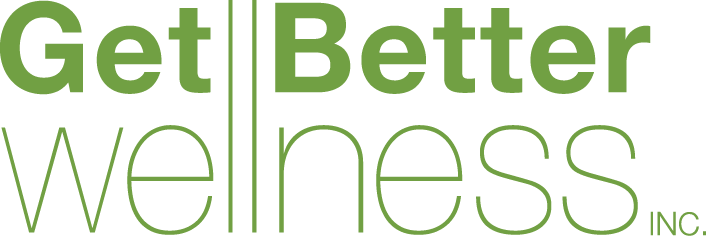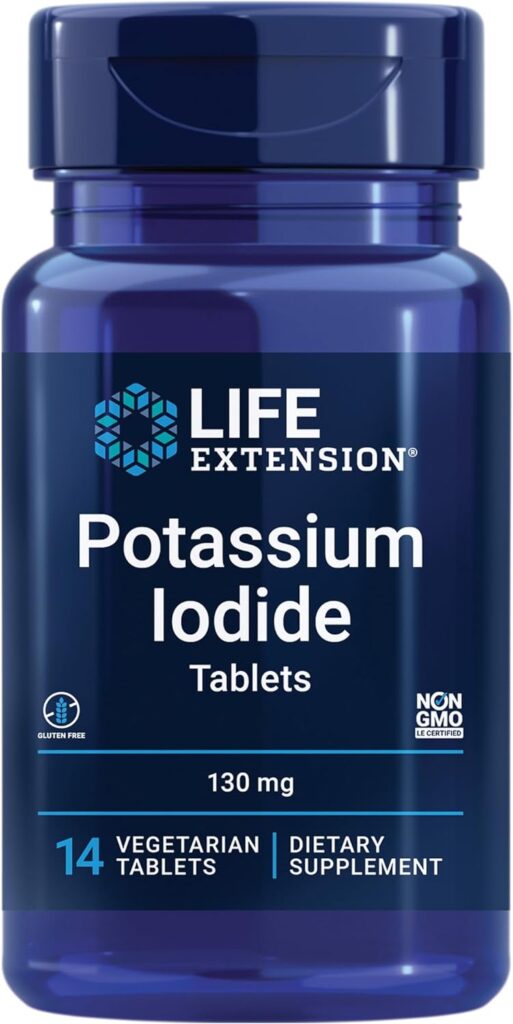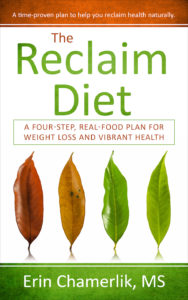
Potassium Iodide and Nuclear War or Nuclear Accident
Be ready to protect your thyroid!
What if we had a nuclear war?
“When the president learns he must respond to a nuclear attack, he has just 6 minutes to do so. Six minutes is an irrational amount of time to “decide whether to release Armageddon”, President Ronald Reagan lamented in his memoirs. “Six minutes to decide how to respond to a blip on a radar scope… How could anyone apply reason at a time like that?” And yet, the president must respond. This is because it takes roughly just 30 minutes for an intercontinental ballistic missile to get from a launch pad in Russia, North Korea or China to any city in the US, and vice versa. Nuclear-armed submarines can cut that launch-to-target time to 10 minutes, or less.
Today, there are nine nuclear powers, with a combined total of more than 12,500 nuclear weapons ready to be used. The US and Russia each have some 1700 nuclear weapons deployed – weapons that can be launched in seconds or minutes after their respective president gives the command. This is what Shirer meant when he said: “Such a war will not last long and none will ever follow it.” [source]
Overview – info from World Health Organization
During a nuclear accident, radioactive iodine may be released in a plume, or ‘cloud’, and subsequently contaminate soil, surfaces, food, and water, as well as settle on an individual’s skin and clothing resulting in external exposure. Radioactive iodine deposited during external exposure can be removed by washing with warm water and soap.
Another type of exposure with greater risk to human health occurs when radioactive iodine is either inhaled or ingested or when substances, such as contaminated food, milk or water, are consumed. Internal exposure, or irradiation, occurs when radioactive iodine enters the body and accumulates in the thyroid gland.
The thyroid gland is at particular risk from irradiation from radioactive iodine because the thyroid uses iodine to produce hormones that regulate the body’s metabolism. The thyroid gland does not differentiate between non-radioactive and radioactive iodine. Uptake of radioactive iodine may increase the risk of thyroid cancer, particularly in children. The younger the age at exposure, the higher the risk is for developing thyroid cancer.
In this situation, potassium iodide is used to protect, or block, the thyroid from irradiation. Commonly known as thyroid blocking, taking potassium iodide (KI)1 before or at the beginning of exposure to radioactive iodine blocks the uptake of radioactive iodine by the thyroid gland, thus reducing exposure of the thyroid to internal radiation.
How KI works
When taken at the appropriate dosage and within the correct time interval around exposure to
radioactive iodine, KI saturates the thyroid gland with stable (non-radioactive) iodine. As a result,
radioactive iodine will not be taken up and stored by the thyroid gland. Any iodine which exceeds the
thyroid’s requirement for production of thyroid hormones (either non-radioactive or radioactive) will
be excreted through the urine within two days.
When to take KI
- KI tablets should be taken by individuals only when explicitly instructed to do so by public health
authorities. Nuclear emergency preparedness usually includes plans to ensure that KI tablets are
readily accessible. - If the implementation of thyroid blocking with KI is warranted, public health authorities should define
the geographic area in which the population should take KI tablets and provide information about
when, how, and by whom KI tablets should be taken. - These instructions may be given through the radio, TV, internet, loudspeakers, and other available channels, and should be carefully followed.
- The effectiveness of KI for thyroid blocking depends on its timely administration. Taking KI shortly
before or immediately at the time of exposure to radioactive iodine offers the most effective
protection. If KI tablets are taken too early or too late, the thyroid is less likely to be effectively or fully protected. If taken 4 hours after exposure, protection will be reduced by half; taking KI more than 24 hours after exposure will offer no protection.
How many KI tablets should be taken?
- Instructions from public health authorities about how KI must be taken should be followed carefully; the correct dose of KI will differ according to age. In the absence of any explicit instruction to the contrary, only one dose of KI should be taken.
- A single dose of KI is usually sufficient for adequate protection for 24 hours.
- In the event of prolonged or repeated exposure, public health authorities may advise taking KI tablets more than once.
- Under such circumstances, neonates (< 1 month) and pregnant or breastfeeding women should not be given repeated doses of KI; other protective actions should be considered for these particular groups on a case-by-case basis and under medical advice
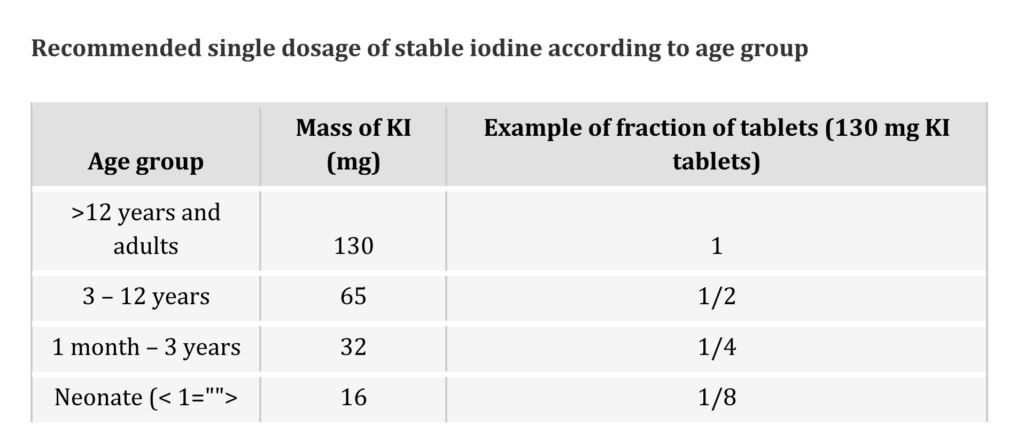
Use of KI tablets in children
The risk of thyroid cancer in children following exposure to radioactive iodine is higher than in adults;
younger age groups are at highest risk. As a result, the protection of children must be considered a
priority when public health authorities distribute and administer KI to individuals. It should be given
to all children at the recommended dosage.
Source: World Health Organization, Use of potassium iodide for thyroid protection during nuclear or radiological emergencies
Product Details: Potassium Iodide Tablets, 130mg
Why take this supplement (only in emergency). Potassium iodide saturates the thyroid gland with stable iodine when taken in a timely manner after exposure to an unstable isotope of iodine (e.g. nuclear power plant emergency).
Provides a high level of iodine (130 mg) as potassium iodide. Potassium iodide saturates the thyroid gland with stable iodine. Intended for short-term use only.
- This product is manufactured in the USA.
- This product has a 24month shelf life from the date of manufacture.
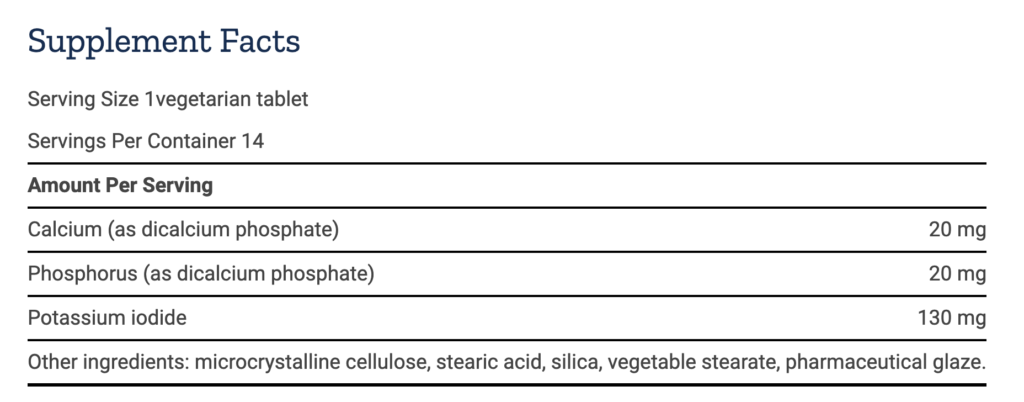
| Dosage and Use |
| NOT FOR DAILY USE. Use only in case of official health warnings. Adults take one (1) tablet. Children 3 to 18 take one half (1/2) thttps://amzn.to/3QifNKGablet. Children 1 month to 3 years take one quarter (1/4) tablet. Newborns from birth to 1 month take one eighth (1/8) tablet. |
| Caution |
| If you have a sensitivity to iodine, consult your healthcare practitioner before using this product. |
Warnings
- KEEP OUT OF REACH OF CHILDREN
- DO NOT EXCEED RECOMMENDED DOSE
Get Better Wellness is reader supported. This post may contain affiliate links, which means that I may receive a small commission when you buy from links on this site. This is at no cost to you.
Recommended
-
Dandelion for Liver Support and Health BenefitsJuly 20th, 2024
-
Modified Citrus PectinJuly 11th, 2024
-
Bentonite Clay Mask for Face and ArmpitsJuly 8th, 2024
-
Two Supplements for Erectile DysfunctionJune 30th, 2024
